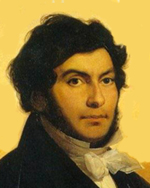Gallery of Philologists
Jean-François Champollion
23 December 1790 - 4 March 1832
The Rosetta Stone had been discovered in 1799 by soldiers with Napoleon's Egyptian expedition, who were extending previous fortifications at Rosetta, a small town near Alexandria. The importance of the stone was immediately apparent to the scholarly world. Its inscription was given in three parallel versions: Greek, Egyptian Hieroglyphic, and the later Egyptian script called "Demotic." From the readily readable Greek version, it was known that the stone had been erected by the Priests of Memphis to celebrate the achievements of the Egyptian king Ptolemy V, and had been written in all the languages then officially current in Egypt. The problem was to use the knowledge of the inscription's content to work out the nature and conventions of the Egyptian scripts, particularly the Hieroglyphic. The phonetic nature of Demotic was established by Silvestre de Sacy, who identified the symbols for "Ptolemy" and "Alexander." The Swedish diplomat Johann Akerblad, who knew Coptic, identified a few further words in Demotic. A translation of the Greek inscription was published in 1802. Thomas Young took the next step by identifying five phonetically written words (enclosed in "cartouches") in the Hieroglyphic version. It looked as though the English were about to duplicate in philology their military success in overcoming Napoleon and the French in Egypt. But there things languished.
Champollion was born in Figeac, in southern France, nine years before the discovery of the Rosetta Stone, and into the turbulence of the French Revolution. No other recourse being available, he was schooled privately by a priest who taught him Greek and Latin. It is said that before he was nine years old, he was able to read Homer and Vergil, and had made at least some effort to learn Hebrew, Arabic, Syriac, Chaldean, and Chinese. He then joined his older brother Jacques Joseph at the Académie de Grenoble. Previously, he had been a linguistically precocious child; at Grenoble, he acquired a focus. Influenced by his brother and by Fourier, a former secretary of the Mission in Egypt, and doubtless stimulated by the recent discovery of the seeming key to Egyptian Hieroglyphic, Champollion continued to study ancient languages in general, but with particular emphasis on Coptic. At 16, in 1806, he presented to the Grenoble Academy of Arts and Sciences a paper in which he suggested that Coptic was the ancient language of Egypt, and thus should provide a clue for the Hieroglyphic script also.
The following year, 1807, he moved to Paris, where he studied Persian, Ethiopic, Sanskrit, Zend, Pehlavi, and Arabic at the Collège de France, in part with Silvestre de Sacy. He also began work on a dictionary and grammar of Coptic. Two years later, still only 19, and exempt from military service thanks to the intervention of Fourier, Champollion returned to Grenoble as an assistant professor of history. In 1814, as the first fruits of this period, he published two volumes entitled L'Éygpte sous les Pharaons, containing the geographical sections of a projected longer work.
The following year, the Faculty of Letters in Grenoble was shut down, and Champollion was left without an academic post. He continued in private with his studies of Coptic. Others, including the English physicist Thomas Young, were also working on the Rosetta stone, and some had published, or anyway had made, useful preliminary observations. After seven years, Champollion made his breakthrough, identifying the relationship between the Hieroglyphic and Demotic Egyptian scripts, both of which turned out to be phonetic. On 14 September 1822, so the story runs, he made his epoch-making discovery; this was the moment when the code finally broke - he had enough of the alphabet solved that he could read names - not the ones he had put in, like "Cleopatra," which he had known and used, but others. On 17 September, he presented his epoch-making Lettre à M. Dacier, he being the permanent secretary of the French Académie des Inscriptions. In the letter, Champollion announced his solution of the Egyptian Hieroglyphic riddle. This was followed in 1824 by a longer thesis on the hieroglyphic, figurative, ideographic and alphabetic writing systems of ancient Egypt. Though Young and his supporters at first disputed priority, it was soon conceded that it was Champollion's work which had led to a full solution of the script, and in the process, had defined the true beginning of Egyptology.
Following this success, Champollion was sent to study the Egyptian antiquities in the museums of Italy, and returned to France in 1926 as the director of the soon-to-be-opened Egyptian Museum at the Louvre. From 1828 to 1830 he conducted his one and only expedition in Egypt, systematically surveying inscriptions on monuments. A professorship in Egyptian history and archaeology was specially created for him in Paris when he returned in 1831, but he presently resigned this position, and devoted the last months of his life to finishing his Egyptian grammar and dictionary. This was published by his brother after his death.
There are monuments to Champollion at Figeac, Turin, and Florence, not to mention the statue in the courtyard of the Collège de France. And in the work of all, since that time,who study Egyptian, anywhere on the globe.
1 Dec 2006 / Contact The Project / Exit to Gallery Index Page

